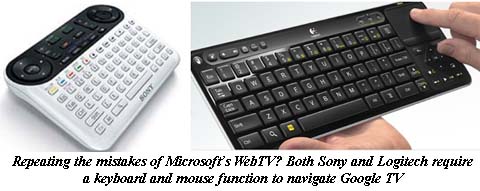“Half-baked” Google TV Leaves CE Vendors Flat
 It was supposed to save TV makers all the trouble of launching and maintaining their own Internet web sites and, in theory, Google’s long history of delivering search data online could be leveraged to finally conquer the television programming guide, with a catch-all guide that would allow users never to miss another episode of Psych again.
It was supposed to save TV makers all the trouble of launching and maintaining their own Internet web sites and, in theory, Google’s long history of delivering search data online could be leveraged to finally conquer the television programming guide, with a catch-all guide that would allow users never to miss another episode of Psych again.
But the search engine giant has pulled back from plans to unveil major Internet TV upgrades from key partners like Toshiba, LG Display and Sharp at the January CES. These are three of the top vendors at the upcoming Consumer Electronics confab, just a few days away. If it were anyone else but Google, causing this much disarray, this close to the biggest US consumer electronics show of they year, CE makers would drop them, never to be seen again. But the solid gold Google can’t be so easily dismissed, so Toshiba et al, are making the best they can out of a less than optimal situation.
“We will not be announcing a Toshiba TV or Blu-ray player or demonstrating the products at CES,” reported the NYT, quoting Jeff Barney, the vice president of Toshiba’s digital products division in the recent Sunday (Business Day, Technology section.) “We have an understanding with Google about the future product roadmap and will bring the right product out at the right timeframe,” he said.
NYT also reported that it looks like LG Display and Sharp are in the same boat, with only Samsung moving forward with announced Google TV plans, and the plans are still a bit sketchy.
In general, most CE makers are shipping certain high-end TVs and BD players with Internet capability, and they are not dependent on the Google TV software to offer these services. Most offer Netflix video streaming, Pandora and YouTube access along with other basic Internet services via Yahoo. Most of these products were announced and shown more than a year ago at CES 2009. Samsung, for example, has its “Internet@TV” web site (with “UK” in the URL) that includes apps, a limited number of TV channels (like History Channel and BBC player), plus some traditional looking applications one finds on the iPhone or Android O/S.
With this Google TV alliance, most analysts were expecting CE makers to deliver a full-blown V.20 upgrade of what was shown last year — only now centered around the mighty Google search engine.
Sony and Logitech were first to the Google TV party, and you can see examples of these products selling in Best Buy or Amazon.com today. But that’s perhaps part of the problem. Anecdotal reports of lackluster sales, along with low rating reviews from recent customers, have purportedly brought about a change in Google’s plans. For example NYT reported “…38 percent of shoppers on Amazon.com gave the Logitech Revue box three stars or fewer, and 19 percent gave it the lowest rating of one star. The main complaints were that it was slow and did not offer more features or programming than other, less expensive set-top boxes.”
One look and most consumers can figure out the problem pretty quickly. Sony sells its G-TV version in a $400 BD player that currently offers little value beyond V.1 offerings currently shipping by CE makers. For example, its flagship TV search feature is currently limited to Dish Network customers, with the promise of “…availability with other cable and satellite providers in the future.” So what do I really get for my $400?
In the Sony product, beyond a standard BD player (not recorder DVR like TiVo, mind you) you get a “fancy” remote that looks so complex, you would think it could launch the Space Shuttle. Check out this image, with the Sony tag line, “Easy to use…” Does this TV remote look anything like “easy?” Can you see your Mom, or her Mom using something like this? Logitech’s solution is a little better with a recently reduced $249 price tag (down from $300), but they are still expecting folks to use a keyboard and mouse on their TV. An approach that flies in the face of conventional “lean-back” TV viewing experience wisdom. Admittedly, the multitasking trend (texting while doing everything else in life) may have tempered this keyboard in the living room phobia a bit—particularly with the younger set, and with respect to TV.
 At present, suffice it to say, the GTV idea is still a bit half-baked. The value proposition leaves a lot to be desired, the dearth of content deals with broadcasters is striking, and basic interface issues still need to be proven out. On that last score, two suggestions: look to the texting model to interface with the TV (like the iPhone/iTouch Remote app for the AppleTV). Better still, lose the remote all together and move to the Microsoft Xbox Kinect gesture driven approach.
At present, suffice it to say, the GTV idea is still a bit half-baked. The value proposition leaves a lot to be desired, the dearth of content deals with broadcasters is striking, and basic interface issues still need to be proven out. On that last score, two suggestions: look to the texting model to interface with the TV (like the iPhone/iTouch Remote app for the AppleTV). Better still, lose the remote all together and move to the Microsoft Xbox Kinect gesture driven approach.
The lesson here — even the mighty Google, bursting at the seams with IQ, can stumble. Only this time it comes on the backs of TV vendors, caught in a tight spot, with million-dollar CES real estate on the line, who are now scrambling for an Internet TV “Plan B.”
Steve Sechrist is a senior analyst and editor for Insight Media. Reach him at steve@insightmedia.info





